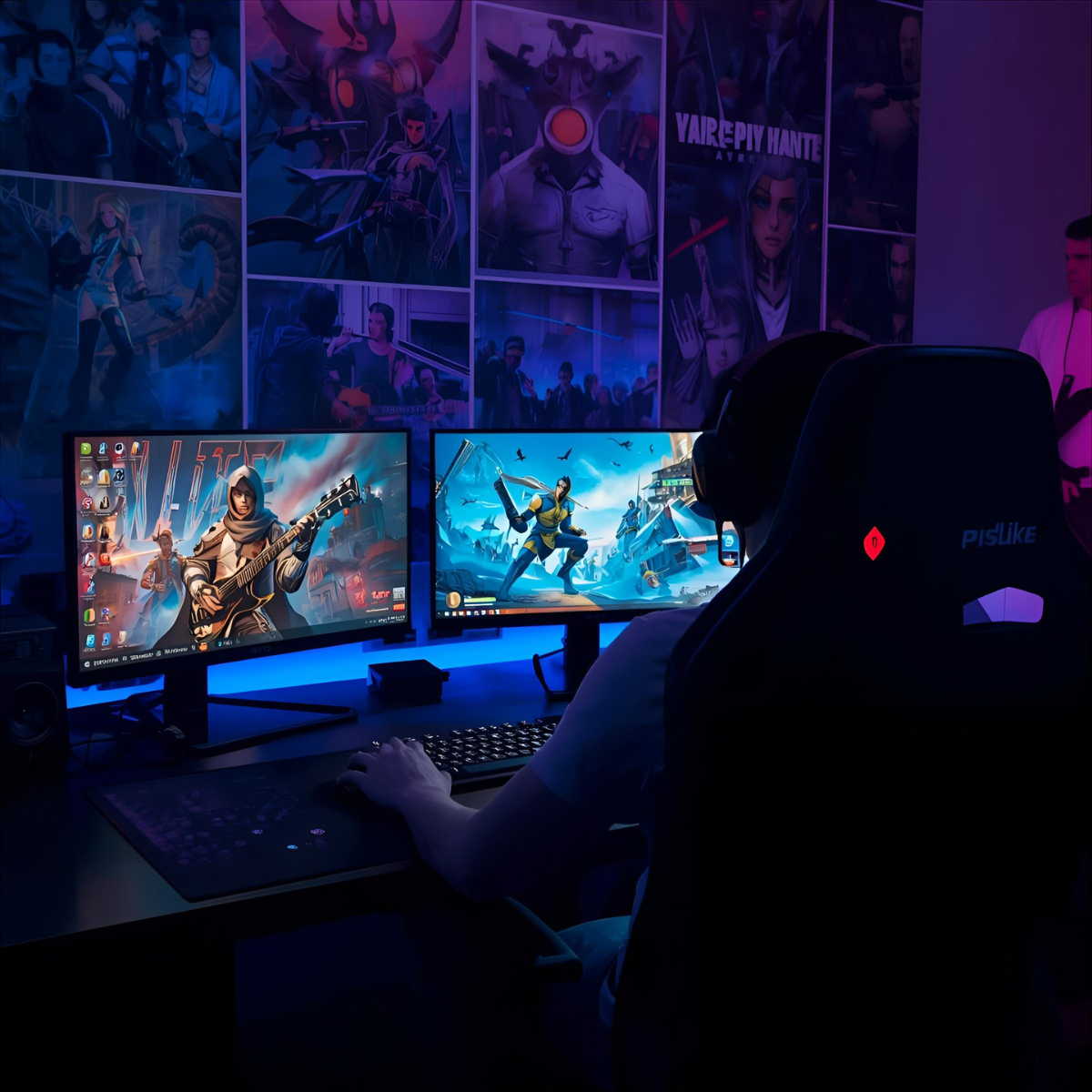
Introduction:
In today’s hyper-connected world, low latency gaming platforms for crossplay define the difference between a good multiplayer experience and a great one. Players expect instant responsiveness, seamless matchmaking, and synchronized gameplay, whether they’re on PC, console, or mobile. At Uverse Digital, our Uverse Multiplayer Game Development framework is built around these exact expectations, engineering for the milliseconds that make or break immersion.
Why Low Latency Matters More Than Ever
Every frame counts in modern multiplayer. A 50-millisecond delay can make a racing game feel sluggish or cause desynchronization in a fast-paced shooter. As cross-platform play expands, latency isn’t just about connection speed, it’s about predictive design, packet prioritization, and network optimization.
Gamers no longer tolerate “lag spikes” or delayed hit registrations. Studies from Newzoo and Unity report that 67% of players abandon games after repeated network disruptions. The modern gaming audience values reliability as much as visuals, and low latency gaming platforms for crossplay are now the foundation of retention.
Crossplay: The New Standard in Player Experience
Crossplay has evolved from a novelty into a baseline expectation. Today’s players demand the freedom to compete, collaborate, and connect across devices, PC, console, mobile, or XR, without interruption or friction. But delivering that harmony requires far more than open servers. It calls for tight network orchestration, precise data synchronization, and a deep understanding of how different hardware ecosystems communicate in real time.
The real challenge lies in making every player’s experience feel identical, regardless of device type, region, or connection quality. Achieving that means neutralizing latency disparities, normalizing physics simulations across engines, and aligning frame updates at the millisecond level. One missed synchronization cycle can cause rubber-banding, desyncs, or input lag — breaking the shared illusion of presence that defines multiplayer immersion.
That’s where Uverse Digital’s crossplay engineering stands apart. Our systems are built for cross-network harmony, not just compatibility. We design frameworks that:
- Equalize network conditions through adaptive tick rate balancing and latency compensation.
- Unify input and control mapping across platforms to ensure fairness and intuitive gameplay.
- Synchronize state and assets through a shared data layer, preventing mismatched visuals or delayed actions.
- Deploy region-aware matchmaking that connects players through the most efficient routes, cutting unnecessary hops and delay.
At Uverse Digital, crossplay isn’t just supported, it’s perfected.
The Technical Backbone: What Powers Low Latency Crossplay
To understand what makes a low latency platform truly crossplay-ready, let’s unpack the three core elements Uverse Digital optimizes:
Edge-Optimized Infrastructure
By deploying global relay nodes and adaptive routing, we minimize the physical distance between players and servers. This lowers round-trip time (RTT) and prevents lag during multiplayer sessions.
Predictive Input Models
We implement advanced client-side prediction to mask latency and maintain gameplay fluidity. This technique ensures that even with slight delays, the game “feels” instant to players.
Dynamic Session Management
Our frameworks adjust server tick rates dynamically based on active players, ensuring smooth synchronization even during large multiplayer sessions.
Each of these layers reinforces our mission to create low latency gaming platforms for crossplay that scale efficiently while preserving responsiveness.
Why Standard Solutions Fall Short
While tools like Photon or PlayFab provide solid baselines, most off-the-shelf solutions struggle when you add real-time synchronization across platforms or variable network quality. These engines weren’t built for modern hybrid architectures, where device diversity and data loads evolve mid-game.
In contrast, Uverse Digital tailors each solution to the project’s physics model, asset streaming pattern, and concurrency demands. We benchmark performance under real-world conditions, mobile data, variable ping, and mixed platforms, to ensure your gameplay loop stays intact.
As Epic’s CTO Kim Libreri said, “Cross-platform parity isn’t a feature, it’s an engineering culture.” That’s the philosophy we embed into every Uverse Multiplayer Game Development project.
Uverse Digital’s Custom Networking Framework
At the heart of Uverse Digital’s approach is our custom networking framework, built for developers who demand precision, scalability, and immersion.
It’s powered by:
- Real-time Synchronization Layer: Keeps player positions, animations, and actions aligned across all connected platforms.
- Adaptive Netcode Engine: Uses latency compensation, lag interpolation, and packet smoothing to maintain uniform experiences across 30–200 ms ranges.
- Secure Relay & Matchmaking Services: Optimized for fair matchmaking and DDoS protection.
- Developer-Friendly SDK: Built for seamless integration with Unreal Engine, Unity, and custom C++ pipelines.
This framework is battle-tested in live environments, from competitive shooters to immersive co-op simulations and continuously refined for modern distributed gaming ecosystems.
Performance at Scale: The Uverse Edge
When latency creeps beyond 100 milliseconds, even the most polished engines begin to stutter. Inputs feel delayed, animations drift, and the illusion of shared reality fractures. To counter this, Uverse Digital engineered The Uverse Edge, a next-generation optimization layer that keeps multiplayer performance smooth anywhere.
The Uverse Edge uses AI-assisted routing prediction and dynamic relay management to identify the fastest possible data path in real time. Instead of relying on static routes, it continuously analyzes network conditions and reassigns traffic to optimal relays.
In practice, that means when a player in Tokyo joins teammates in Los Angeles and Berlin, their data doesn’t take a linear path. The Uverse Edge intelligently triangulates the shortest and most stable routes, shaving off precious milliseconds.
This architecture consistently delivers up to 60% lower ping, 4x less packet loss, and stronger session stability, directly translating into longer play sessions, higher retention, and better monetization outcomes.
For developers, this means fewer post-launch patches, predictable player metrics, and lower operational costs. With The Uverse Edge, Uverse Multiplayer Game Development achieves true performance at scale.
Building for the Future of Multiplayer
The evolution of low latency gaming platforms for crossplay is intertwined with emerging technologies, 5G, edge computing, and AI-driven optimization. Uverse Digital is already building for that future through:
- 5G-Optimized Protocols: Harnessing local compute to minimize data hops.
- AI-Assisted Lag Prediction: Anticipating and correcting delay spikes before they occur.
- Lightweight XR and Cloud Gaming Support: Designed for immersive, cross-device experiences with minimal input delay.
As multiplayer expands into XR and metaverse-scale ecosystems, latency control will define user experience and Uverse Digital ensures studios stay ahead of the curve.
Real-World Application: A Glimpse Behind the Scenes
In a recent global co-op project spanning mobile and desktop, players across four continents performed hundreds of concurrent actions with sub-50 ms response times. By integrating Uverse Edge routing and our Predictive Input Layer, we reduced average input delay by 38%, achieving flawless synchronization between Android, Windows, and console players.
It wasn’t theory, it was the difference between a playable prototype and a commercially ready title. Developers gained network stability, and players experienced perfectly aligned sessions without noticing the underlying complexity.
Developer Empowerment: Beyond the Framework
Uverse Digital doesn’t just deliver technology, we empower studios with transparency and control. Our partners gain access to:
- Custom Performance Dashboards to track latency and user distribution.
- Server Load Testing Environments simulating global concurrency.
- Ongoing Optimization Support for post-launch crossplay stability.
We treat networking as a creative enabler, not a limitation, letting developers focus on gameplay innovation, not packet management.
Why Studios Choose Uverse Digital
Top developers partner with Uverse Digital because we combine engineering precision with production-grade reliability:
- End-to-End Expertise: From architecture to post-launch optimization, we handle every layer.
- Proven Crossplay Capability: Seamless integration across all major platforms.
- Scalable Solutions: From indie co-ops to massive multiplayer ecosystems.
- Collaborative Partnership: We act as your in-house multiplayer engineering team.
Every solution we deliver reflects our philosophy, latency is invisible only when engineering is exceptional.
The Business Impact of Low Latency
Reduced latency doesn’t just enhance gameplay, it drives business growth. Games running under 60 ms average 23% higher retention and 15% stronger in-app conversion. Crossplay further expands reach, connecting ecosystems and fostering unified communities.
By combining low latency with cross-platform accessibility, Uverse Digital helps studios build games that perform, scale, and sell.
Key Takeaways for Studios
- Low latency equals engagement: Every millisecond shapes retention.
- Crossplay requires orchestration: Generic frameworks can’t ensure consistency.
- Custom netcode wins long-term: Tailored architecture scales better.
- Partner early: Integrating low latency systems from day one saves cost and time.
With Uverse Multiplayer Game Development, your vision never falters under network constraints.
FAQs: Low Latency Gaming Platforms for Crossplay
Q1. What defines a low latency gaming platform for crossplay?
It’s an architecture enabling real-time synchronization between players on different devices with minimal delay (under 60 ms). It balances bandwidth, prediction, and relay efficiency.
Q2. Why is Uverse Digital different from standard SDKs?
Unlike generic tools, Uverse Digital builds custom netcode matched to your game’s mechanics, concurrency model, and device mix, delivering smoother sync and lower ping.
Q3. How does latency affect monetization?
Higher latency shortens play sessions and frustrates users. Optimized latency improves engagement, session time, and conversion rates.
Q4. Can Uverse Digital handle global server distribution?
Yes, our Uverse Edge and adaptive relay nodes maintain stability worldwide, optimizing routes dynamically for consistent sub-50 ms performance.
Q5. Is your framework compatible with Unreal and Unity?
Absolutely. Our SDK integrates seamlessly with both, as well as custom C++ pipelines.
Ready to Build Seamless Multiplayer Experiences?
If your next project demands performance, scalability, and reliability, Uverse Digital is your ideal partner.Don’t let latency limit your game’s potential.
Reach out to Uverse Digital and get a quote for building scalable, crossplay-ready multiplayer experiences.
Contact Us
Explore Uverse Digital’s Services
About the author : Uverse Digital
Stay Ahead of the Game
Get XR insights, dev tips, and industry updates straight to your inbox
Join our insider list for cutting-edge content on game development, performance optimization, and immersive experiences — curated for industry leaders like you.



